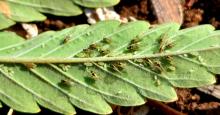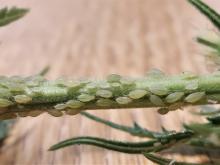Includes:
Cannabis aphid/hemp aphid/bhang aphid (Phorodon cannabis)
Green peach aphid (Myzus persicae)
Potato aphid (Macrosiphum euphorbiae)
Rice root aphid (Rhopalosiphum rufiabdominale)
Pest description and crop damage Several aphid species (Order: Hemiptera; Family: Aphididae) are pests of hemp in the PNW. Aphids are soft-bodied insects with a pair of abdominal cornicles that exude pheromones or defensive secretions. The most common aphid species associated with hemp plants include green peach aphids, potato aphids, rice root aphids and cannabis aphids. In general, green peach aphids are pale or dark green in color; potato aphids are pink and green in color; cannabis aphids are light green, pale pink and light brown in color; and rice root aphids are olive-red in color. However, aphid species identification based on the color alone is often not accurate. All these aphids can be recognized by observing the antennal tubercles under a stereo microscope: convergent tubercles on green peach aphids; upward sloped tubercles on potato aphids; horn-like projections on cannabis aphids; and no clearly visible tubercles on rice root aphids.
Among these, cannabis aphids and rice root aphids are the most damaging aphids, usually under indoor hemp production systems. The cannabis aphid is found on the leaves, stems and flower buds of hemp plants, while the rice root aphid is found below ground and at the base of the plant. In outdoor production, aphids are generally controlled by natural enemies. Cannabis aphids are common in indoor and outdoor hemp production systems; but, so far, rice root aphids have not been found in outdoor production in the PNW.
Biology and life history Potato aphid and green peach aphid have broad host ranges, and they feed on many crops, weeds, and native plants. In contrast, the cannabis aphid is a specialist herbivore, and feeds only on hemp plants. Potato aphid and green peach aphid winged adults arrive on hemp from weeds and various host crops where they overwintered as eggs, nymphs and adults. Both aphid species are usually found to colonize the hemp plants during spring season. So far, it is not clear how cannabis aphids are transported to outdoor hemp plants, but it is likely that adults move from greenhouse transplants or from volunteer field plants, and high populations are present on hemp plants during summer and fall seasons. Throughout the growing season, all aphids produce live young, all of which are female and can be either winged or wingless. Winged aphids tend to be produced more often when the aphid population becomes crowded. In the fall, when winged males (potato aphids or green peach aphids) are produced, they fly to overwintering hosts and mate with egg-laying females produced on that host. In the case of cannabis aphids, eggs, which are initially yellow-green and then turn black, are laid on the hemp leaves surrounding the bud. These eggs can remain dormant through the winter and hatch in the spring. All species may undergo multiple overlapping generations per year.
Scouting and thresholds Plants should be checked for aphids at least weekly starting shortly after emergence. When plants are upright, the most effective scouting method is to shake plants above beating sheets, beating trays, or white half-gallon ice cream buckets. This sampling method will evaluate the presence of aphids at a single point in time. In some hemp varieties, the shoots become very long and bushy and become intertwined, making scouting difficult. In this case, sampling and inspecting individual leaves could be useful. Another method that can be helpful to determine the aphid presence on hemp plants is to install the yellow sticky traps at the field edges for outdoor production or hang the traps near the plants for greenhouse production. Traps should be monitored at weekly intervals. Currently, there are no established treatment thresholds for aphids that warrant insecticide application. However, monitoring of aphids can help to develop a pest management program.
Management-biological control
In outdoor production, hemp harbor large numbers of generalist predators that can prey on aphids feeding on hemp plants. These include the hemipteran bugs: minute pirate bug (Orius spp.), big-eyed bug (Geocoris spp.) and damsel bug (Nabis spp.). Other common aphid predators include lady beetles and their larvae, lacewings, and syrphid (or flower fly) larvae. Aphid-specific parasitoid wasps (Aphidius spp. and Aphelinus spp.) may also present on hemp fields. However, the role of natural biological control agents in suppressing the aphid population in hemp has not been explored in the PNW. For indoor production, several commercially available biological control agents (such as Aphidius colemani for green peach aphids, Aphidius matricaria for cannabis aphids) can be used to manage aphid populations.
Management-cultural control
Consider transplanting healthy seedlings from reliable sources.
Management-chemical control
See:


